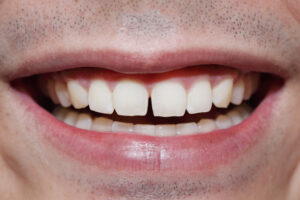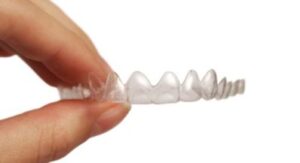Can Cosmetic Bonding Improve My Smile?
 When it comes to cosmetic dental treatments, you have many different options to achieve the smile improvements you desire. One of those options is cosmetic bonding, the official dental term for which is composite resin restoration. You might hear of this treatment referred to as bonding, composite, resin, or tooth-colored filling. Don’t let the many different names confuse you. They all describe the same thing.
When it comes to cosmetic dental treatments, you have many different options to achieve the smile improvements you desire. One of those options is cosmetic bonding, the official dental term for which is composite resin restoration. You might hear of this treatment referred to as bonding, composite, resin, or tooth-colored filling. Don’t let the many different names confuse you. They all describe the same thing.
What is Cosmetic Bonding?
When dentists use the term “cosmetic bonding”, they are referring to the dental treatment of reshaping the teeth by adding perfectly matched filling material. The material is a composite resin, which is the same type of material used for the fillings that repair cavities and cracked teeth. There are various types of composite resin used for different applications. For cosmetic applications, we will use one that is highly polishable and suited for front teeth.
The reason some people call it “bonding” is the fact that composite resin achieves a micromechanical attachment to hard tooth structure. This attachment forms a firm bond with healthy enamel and dentin. This is the same mechanism of attachment dentists use to “glue” brackets to the teeth for orthodontic treatment.
What Types of Smile Problems Can Cosmetic Bonding Correct?
 Cosmetic bonding is generally an additive process. It is a wonderful treatment option for smile problems that can be corrected by adding to the shape of the teeth. This means that there should be room for the adding of material, and if there is not, your dentist may need to remove some tooth structure. In order for cosmetic bonding to remain as conservative as possible, we only remove what is necessary to make room for the composite material.
Cosmetic bonding is generally an additive process. It is a wonderful treatment option for smile problems that can be corrected by adding to the shape of the teeth. This means that there should be room for the adding of material, and if there is not, your dentist may need to remove some tooth structure. In order for cosmetic bonding to remain as conservative as possible, we only remove what is necessary to make room for the composite material.
The best smile problems to correct with cosmetic bonding are the following.
- Small gaps between the teeth
- Teeth that appear too small compared to their neighbors
- Teeth with uneven biting edges
- Teeth that have chipped or broken
- Teeth worn down or shortened over time
What Does the Process of Cosmetic Bonding Involve?
In order to achieve the best cosmetic result, Dr. Ann may perform a pre-operative step known as a “wax-up”. This preparation step allows her to make the cosmetic changes to the tooth or teeth on a replica of your teeth prior to performing the procedure in the mouth. This allows her to obtain exact measurements of any needed removal and any added material for the most precise and best-looking restoration!
One of the greatest advantages of cosmetic bonding is that, because it is additive in nature, it usually requires no local anesthetic. Even if some removal of tooth structure (drilling) is necessary, it is only minor and should not cause any discomfort.
So, without any numbing, Dr. Ann will remove any necessary enamel to achieve the best result, which may involve a minor amount of drilling and cold water. Then she prepares the tooth with the required adhesives and builds the tooth to the desired goal. After shaping the material to the exact specifications, she cures, or hardens, the material with a specialized light.
Final contouring and polishing does include a little drilling, but none of it occurs in the tooth. It is all superficial and causes no pain or discomfort. Dr. Ann will make sure it is smooth, shiny, and invisible to the naked eye.
Does Bonding Last as Long as Veneers?
Great question. And one that is difficult to give a straight answer.
Bonding, when performed correctly with a high level of skill (as it always is at Designer Smiles), can last as long as porcelain veneers. The important thing to understand is that the problems which affect the lifespan of cosmetic bonding would also affect the lifespan of porcelain veneers.
For example, someone who clenches or grinds the teeth heavily during sleep has a high risk for chipping or breaking their cosmetic bonding. They would also have a high risk for chipping or breaking porcelain veneers. Someone who has a high risk for cavities can develop one under cosmetic bonding just as easily as developing one beneath a porcelain veneer.
Veneers do carry the advantage of less staining over time, so they will typically maintain their color better than cosmetic bonding in general.
How Much Does Cosmetic Bonding Cost?
The cost of bonding depends on the size of the change being made and the number of teeth treated. Fixing a small chip in a front tooth with cosmetic bonding costs about the same as a small dental filling. Covering the majority of the front teeth with cosmetic bonding will cost more along the lines of veneers. One advantage of bonding is that it is more versatile, so its cost can vary much more widely than other cosmetic treatment options.
In general, the cost is closer to that of fillings than that of porcelain veneers.
Why Do I Need Cosmetic Bonding after Invisalign?
 Some people may need cosmetic bonding after they have undergone orthodontic treatment with Invisalign. This is actually quite common, especially in adults. When teeth are in a crowded position for a long period of time, the biting edges will wear or shorten according to that position. Then, after straightening them with Invisalign, the teeth will be in the correct position, but the biting edges will have uneven or strangely angled edges. This leads to a situation in which the teeth are straight, but they do not look straight.
Some people may need cosmetic bonding after they have undergone orthodontic treatment with Invisalign. This is actually quite common, especially in adults. When teeth are in a crowded position for a long period of time, the biting edges will wear or shorten according to that position. Then, after straightening them with Invisalign, the teeth will be in the correct position, but the biting edges will have uneven or strangely angled edges. This leads to a situation in which the teeth are straight, but they do not look straight.
In these cases, Dr. Ann can replace the tooth structure missing from those biting edges with cosmetic bonding, which will create the final appearance of teeth that are straight and also look straight.
Can I Whiten My Teeth after Cosmetic Bonding?
Great question!
The composite resin material itself will not respond to teeth whitening chemicals, but the surrounding natural tooth structure will. This could lead to an unnatural appearance, so we do NOT recommend teeth whitening after cosmetic bonding is performed on the teeth. We would only want you to whiten if the natural tooth structure had accumulated stains and became darker than the composite material.
However, it is a wonderful idea to whiten your teeth before you have cosmetic bonding performed. Achieving your desired tooth color through teeth whitening prior to any cosmetic dental treatments is always a good idea. Because the chemicals in teeth whitening do interfere with the adhesive bond between composite resin and enamel, we require a two week rest period after any whitening before we apply the cosmetic bonding.
So whiten away! Call us when you are happy with the color, and we will schedule your bonding visit for two weeks later.
More Questions about Cosmetic Bonding?
Call Designer Smiles today to schedule a cosmetic consultation with Dr. Ann. She will assess your smile and answer your questions to help you determine whether cosmetic bonding will meet all of your smile goals.
